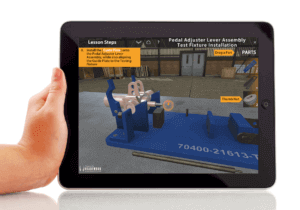Courtesy of Google Glass, Vuzix, and other new hardware, Augmented Reality (AR) has had its share of attention in the last two years. In this post, we discuss the state of AR technology specifically for Operations & Maintenance Training.
Many confuse Virtual Reality (VR) and Augmented Reality (AR), so let’s start with a simple definition that covers most Augmented Reality use cases: AR is the technology where digital data is overlaid on a ‘live’ view of the real world. When this data (like text, graphics and sound) is contextually displayed on a person’s real-time view, it can open up new ways to learn about one’s surroundings, from navigating a street we are walking on or practicing the best way to work on a piece of equipment. This visual description shows AR for machine maintenance in action:
Looks promising, doesn’t it? But does it really help one learn easier or faster?
Yes! The good folks at Colombia University concluded, through a series of tests, that users completed the same task in 53% of the time, and more accurately than previous forms of instruction. They also found it to be a more natural and intuitive way of learning.
So as a training leader in your organisation, you’re probably thinking you should invest in Augmented Reality technology – but you shouldn’t.
Why?
AR is not at the cutting edge of technology right now – it’s at the bleeding edge. And I’m not thrilled to say so, because from a business standpoint, I look forward to offering interactive AR Solutions for enterprises to buy from Heartwood. But we have had the opportunity to analyze training initiatives at countless organisations – and here is what we’ve found:
The problem with Augmented Reality today
1. ‘Risk mitigation’ is a huge worry for enterprise leaders – and for good reason. It’s crucial to know that technology that works in ideal test conditions will also work in the field, on-site, without internet, or at 3 a.m.! Unfortunately, AR does not pass this test. The recognition software is not robust enough to handle all light conditions equally, with extremely dark, light or reflective backgrounds sometimes resulting in potentially catastrophic errors. (Imagine an arrow pointing to the wrong screw!)
2. Requiring additional hardware, like a head-mounted set of glasses just means lugging around more stuff that runs out of batteries – and more cables and chargers to carry around. Not only is this cumbersome (and awkward), technicians do NOT want another hi-tech device, so user adoption will be an issue.
3. Most training happens at a slower pace than live performance, and certainly not just on one specific day. Technicians want – and need – access to that knowledge at all times, not just when they are in front of the equipment.
Our professional recommendation? Stick with Virtual Interactive Training. Here’s why:
 1. Technicians and trainees already have access to mobile devices, tablets and laptops, so it makes sense to deploy virtual training apps that use 3D interactivity and allow them to ‘learn-by-doing’ on those same devices. Although it doesn’t point to the actual real world screw (as it does in AR), it will train them on what to do on a virtually replicated 3D model of that screw. For most techs, that is already a HUGE step up from passive PowerPoint-style courses they are accustomed to. See samples of 3D Interactive Virtual Traing here.
1. Technicians and trainees already have access to mobile devices, tablets and laptops, so it makes sense to deploy virtual training apps that use 3D interactivity and allow them to ‘learn-by-doing’ on those same devices. Although it doesn’t point to the actual real world screw (as it does in AR), it will train them on what to do on a virtually replicated 3D model of that screw. For most techs, that is already a HUGE step up from passive PowerPoint-style courses they are accustomed to. See samples of 3D Interactive Virtual Traing here.
2. Management can rest assured knowing that every single time the virtual training app runs, it will display the same accurate information, regardless of conditions – day or night, inside or outside. RISK successfully MITIGATED.
3. Since the 3D interactive content will already be developed, we can re-purpose it into AR applications when the technology is more stable and more importantly, when enough users have the hardware needed. We predict this will happen in five to seven years.
So when it comes to training for mission critical systems, and presented with a set of features that work every single time (Interactive Virtual Training) and a promising new technology that works only of the time (Augmented Reality) – the choice is clear (for now).
Have you had any experience with AR? We’re happy to answer questions about either technology. Reach out!
Note: This post was first published on the MRO-Network Website


